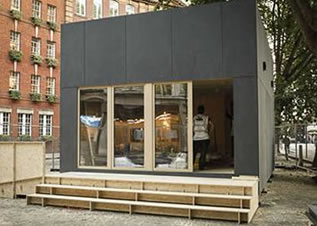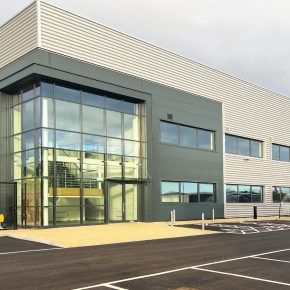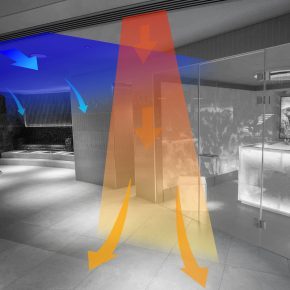
Can 3D printing end the housing crisis and even be used to colonise the moon?
Pictures of Wikihouse 4.0 courtesy of photographer Margaux Carron
As the worlds first flat-pack, affordable Wikihouse 4.0 officially opened to the public this week as part of the London Design Festival, the benefits of using 3D printing in construction are becoming more accepted amongst industry professionals, who believe that the method could be used to end the housing crisis currently being experienced across large parts of the UK.
Constructed over a period of eight days at a cost of just andpound;50,000, Wikihouse is a two-storey, two bedroom property designed with CAD software and with no real help from professional builders or architects during the design or construction.
Wikihouse is not the first home to be constructed using 3D printing; Dutch architects are currently in the process of building a full sized printed house that is waste free, eco friendly and mainly designed using a plastic based on plant oil. Whilst a Shanghai based engineering company built 10 full sized homes in 24 hours using a giant 3D printer, at a cost of less than andpound;3,000 each.
Nasa is also working with Dr Behrokh Khoshnevis of Contour Crafting, who aims to create a Martian settlement on the moon by 3D printing concrete buildings layer by layer, using a giant robotic printer and lunar rock.
The companys construction systems are being developed in order to utilise lunar regolith as a building material and create structures that include integrated radiation shielding, plumbing, electrical and sensor networks.
Contour Craftings technology can also be put into practice to construct a 2,000 square foot house with utilities for electrical and plumbing in less than 24 hours, designed for people needing emergency housing in the aftermath of a hurricane, earthquake or tsunami – a quick-fix technique which the industry desperately needs should any more natural disasters occur.
Over in the car manufacturing industry, Le Mans car designers also turned to 3D printing in order to test out their designs recently; whilst the futuristic car, Strati, was created in just 44 hours using 40 parts and direct digital manufacturing techniques.
3D printing allows anyone with access to a specialised printer to create anything they want. Although there are certain limitations to what can be printed in terms of materials and size constraints, the technology has endless possibilities for the world of architecture and design in general.
Latest news

2nd April 2025
FIT Show 2025 Launches Innovative Marketplace Feature to Enhancing Value for Installers
FIT Show, the UK’s leading event for the window, door, flat glass, hardware, and roofing industries, is excited to announce the launch of a brand new Marketplace feature at its upcoming 2025 event (Birmingham NEC, 29 April – 1 May).
Posted in Architectural Ironmongery, Articles, Building Industry Events, Building Industry News, Building Products & Structures, Doors, Exhibitions and Conferences, Glass, Glazing, Hand Tools, Innovations & New Products, Plant, Equipment and Hire, Power Tools, Restoration & Refurbishment, Retrofit & Renovation, Roofs, Seminars, Training, Windows
2nd April 2025
Hi-spec deployment of EJOT Colorfast at new Birmingham logistics park
EJOT Colorfast fasteners have been used extensively in the construction of eight new high-specification warehousing and logistics buildings at the Urban 8 Logistics Park in King’s Norton, Birmingham.
Posted in Articles, Building Industry News, Building Products & Structures, Building Systems, Case Studies, Facades, Restoration & Refurbishment, Retrofit & Renovation, Roofs, Walls
2nd April 2025
SWA member delivers ‘fresh Hope’ for university’s Sustainable Building department
A detailed contract to restore an iconic Art Deco building in the heart of Birmingham’s Jewellery Quarter was carried out by Steel Window Association member, The Window Repair Company (Northwest) Limited.
Posted in Articles, Building Associations & Institutes, Building Industry News, Building Products & Structures, Building Systems, Case Studies, Glass, Glazing, Restoration & Refurbishment, Retrofit & Renovation, Steel and Structural Frames, Sustainability & Energy Efficiency, Windows
1st April 2025
Gilberts Takes Thermal Comfort to New Heights
Gilberts Blackpool is continuing to build on its reputation as a pioneer with the unveiling of ThermaAstute™ – the most extensive range of thermally sensitive diffusers in the market.
Posted in Air Conditioning, Articles, Building Industry News, Building Products & Structures, Building Services, Facility Management & Building Services, Heating, Ventilation and Air Conditioning - HVAC, Innovations & New Products, Restoration & Refurbishment, Retrofit & Renovation, Sustainability & Energy Efficiency
 Sign up:
Sign up: